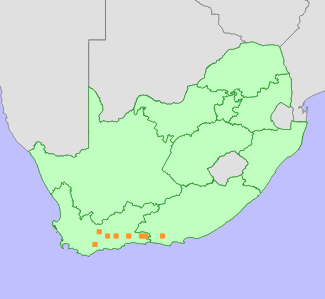|
Scientific Name | Drimia cochlearis Mart.-Azorín, M.B.Crespo & A.P.Dold |
Higher Classification | Monocotyledons |
Family | HYACINTHACEAE |
National Status |
Status and Criteria | Least Concern |
Assessment Date | 2014/04/02 |
Assessor(s) | L. von Staden |
Justification | Widespread and not in danger of extinction. |
Distribution |
Endemism | South African endemic |
Provincial distribution | Eastern Cape, Western Cape |
Range | Bredasdorp to the Baviaanskloof. |
Habitat and Ecology |
Major system | Terrestrial |
Major habitats | Albany Thicket, Fynbos, Succulent Karoo |
Description | Deep sandy soils, rocky outcrops or ledges in dry shrubland, 150-900 m. |
Population |
Plants occur in scattered subpopulations of single plants or dense clumps (Martínez-Azorín et al. 2013). Currently, it is known from only a few isolated subpopulations, but may also be overlooked.
|
Population trend | Stable |
Assessment History |
Taxon assessed |
Status and Criteria |
Citation/Red List version | | Drimia cochlearis Mart.-Azorín, M.B.Crespo & A.P.Dold | Least Concern | 2014.1 | |
Bibliography |
Martínez-Azorín, M., Crespo, M.B. and Dold, A.P. 2013. Drimia cochlearis (Hyacinthaceae), a new species from South Africa. Systematic Biology 38(2):332-338.
|
Citation |
| von Staden, L. 2014. Drimia cochlearis Mart.-Azorín, M.B.Crespo & A.P.Dold. National Assessment: Red List of South African Plants version 2024.1. Accessed on 2025/12/01 |
 Comment on this assessment
Comment on this assessment


